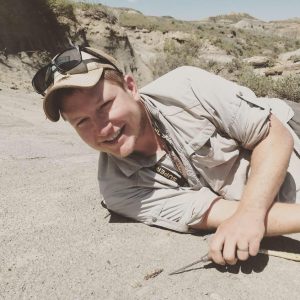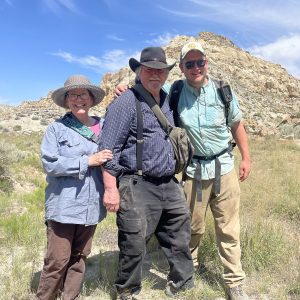Anthropology BA, Biological Anthropology concentration 2015
As a self-proclaimed “overconfident 20-year-old undergraduate with no real direction,” Luke Weaver recalls signing up for the very first CSU Paleontology Field School in 2013, led by Associate Teaching Professor Kim Nichols and Dr. Tom Bown, “intrigued by the idea of camping in the badlands of Wyoming and playing Alan Grant from Jurassic Park for a few weeks.” The intrigue has lasted a little longer. Luke (ANTH, Biological Anthropology BA 2015) is a newly appointed Assistant Professor in the Department of Earth Sciences at Kent State University in Ohio, studying the early evolution of mammals, from the “Age of Dinosaurs” to shortly after the mass extinction that ushered in the “Age of Mammals” and leading his own research program in Wyoming’s Bighorn Basin.
Luke completed his Ph.D. in the Department of Biology at the University of Washington in fall 2015, advised by Dr. Greg Wilson Mantilla. His research focused on the evolution of multituberculate mammals, a now-extinct group that for more than 130 million years were the most abundant and diverse mammals on Earth. Luke also completed a National Science Foundation Postdoctoral Research Fellowship at the University of Michigan, working with Dr. Catherine Badgley and geologists in the Earth and Environmental Sciences Department to explore the role that the rise of the Rocky Mountains might have played in stimulating the evolution of mammals during the Cretaceous Period. His work has been published in the journal Nature among other publications. Luke has won the Romer Prize from the Society of Vertebrate Paleontology for Best Student Talk and the Presidential Award from the American Society of Naturalists for Best Paper, published in The American Naturalist.

What is your current position?
Assistant Professor, Department of Earth Sciences, Kent State University. You can find details on my research program through the research tab on my website: lucasnileweaver.com.
What is your favorite part of your job?
Fieldwork is my favorite part of my job. I spend 1–3 months every summer in the American West — mostly Wyoming, Montana, and Colorado — collecting mammal fossils from 90–60 million years ago, leading up to and across the Cretaceous-Paleogene mass extinction event, which killed all dinosaurs except for birds. I also study the rocks in which those fossils are found to understand how mountain building, sea level rise and fall, changes to river systems, and climate change might have influenced the evolution of mammals.
I also love mentoring students, and I do a lot of this both in the lab and in the field.
What are you researching now?
My big project I’m leading now is focused on Cretaceous and early Paleocene rocks in the Bighorn Basin of Wyoming — this has been really fun because Kim Nichols and Tom Bown first introduced me to paleontology and geology fieldwork in the Bighorn Basin in 2013 when I was an undergrad at CSU.
How did your experiences as a CSU Anthropology student lead to your career path?
I had no clue what I wanted to do with my life and I was an undeclared major when I took Kim Nichols’ [ANTH 120, Human Origins and Variation] course on a whim. When she advertised the inaugural Paleontology Field School, I applied simply because it sounded cool. From those chance encounters, I stumbled upon my life’s passion. By the end of the summer 2013, I was sold that I wanted to grow up to be like Tom Bown! I wanted to be a paleontologist. So, CSU Anthropology and the Paleontology Field School are the entire reason I got into paleontology and had the opportunity to pursue this career.
Seeing the freedom with which Kim and Tom explored scientific questions, and watching their interactions with lifelong colleagues is one of the main things that drew me to paleontology, and the mantra that science should be fun has always stuck with me.
What knowledge and skills from your degree have been most useful since leaving CSU?
The evolutionary and geological background I learned at CSU are things I use every day in my research—both in the lab and in the field. But more broadly, working with Kim and Tom instilled in me the importance of curiosity and friendship in science. Seeing the freedom with which Kim and Tom explored scientific questions, and watching their interactions with lifelong colleagues is one of the main things that drew me to paleontology, and the mantra that science should be fun has always stuck with me.

What are you most proud of since graduating from CSU?
That’s a hard question… I am proud of the relationships I’ve built through my career. I consider almost all of my colleagues friends, and some of them are my best friends. That is pretty special, I think. For more concrete things, I’m proud of the fact that I’ve built my own field research program in the Bighorn Basin, which feels like coming full circle from when I started down this path at CSU.
Is there a specific class or experience from CSU that has stuck with you?
Literally every class I took from Kim was formative for me, but ANTH 376 (Evolution of Human Adaptation) was probably the most impactful because it covered the entirety of vertebrate evolution, not just the specifics of humans. The Paleontology Field School was by far the most influential course I took as a student.
One memory that sticks with me is finding my first mammal jaw, it was of the Eocene tapir Homogalax, and the adrenaline rush was unlike anything I’d felt before. That is when it really clicked for me. I remember later that evening asking Tom to borrow some of the reprints he had with him in the field, and sitting in camp late into the evening reading about ancient primates and soaking up everything I could possibly learn about early mammals.
What do you do when you’re not studying ancient mammal teeth and evolution?
I’m a die-hard Colorado sports fan, especially football, basketball, and hockey. Coach Norvell is gonna put the Rams back on top of the Mountain West this year! I am also a huge live-music fan, especially Phish and other jam bands. And I love to cook.